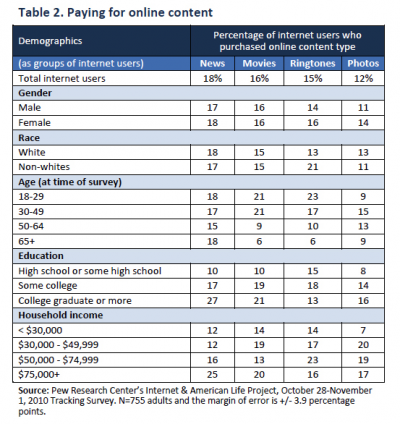Sharing Subscription Services
Contents
Examples
Companies may package access to their product offline and online through a single subscription or through multiple subscriptions. Pricing may differ between offline vs. online access for the same content delivered differently.
Online
Websites of:
- News providers
- Wall Street Journal
- New York Times
- Directories
- Angie's List
- Consumer Reports
- Movie and Music providers
- Netflix
- hulu
- Rhapsody
- Apple Music
- Fashion and Styling
- JewelMint
- myGlam
- FabFitFun
- StitchFix
Note: Subscribers do not have an equivalent level of ownership online vs. offline. A company may terminate their website or remove content or service elements of their website at any time. Subscribers do not have the power to make decisions about their subscription or establish ownership online; companies’ ownership reigns through the entire lifecycle of the subscription.
Offline
Many, but not all, offline subscription services provide a subscriber with a physical good.
- Newspapers
- Wall Street Journal
- New York Times
- Magazines
- Sports Illustrated
- WIRED
- Directories
- The Yellow Pages
- Movie and Music providers
- Netflix
- Sirius XM Radio
- Gym Memberships
- Media Subscriptions
- Internet
- Cable television
- Telephone
Sharing
To share is to grant someone else joint or individual access or ownership of a resource. Based on the nature of the resource, the original owner of the resource may maintain or revoke his or her ownership. An individual may share a resource temporarily, such as a book. Depending on the context, “to share” may be synonymous “to borrow” or “to permit use for a given period.” “To share” may also mean “to give,” as is the case with food. If an individual shares his/her food with another, he/she does not expect it back.
Differences in ownership
Example: Online vs. offline newspaper subscription. The subscription owner (i.e. customer) may elect to allow someone else to read Section A as he or she reads Section B and then both readers may exchange sections of the newspaper. There is no change in ownership. In the case that the owner does not like Section B, he or she may share Section B with someone else and not expect Section B to be given back – the other person assumes ownership of Section B. An online newspaper subscription enables the ability of multiple persons to access a resource simultaneously while an owner maintains ownership.
Foundation
Parents and role model figures teach and encourage children to share without constructing a distinction between sharing in online and offline environments. Sharing has developed into a behavior universally associated with positive character traits such as thoughtfulness and generosity and from which an individual may gain pleasure and satisfaction. Individuals deem sharing of information, resources, and access as an altruistic act regardless of the item being shared and the environment in which it is shared.
Societal Benefits
The Roman philosopher Lucius Annaeus Seneca once stated, “There is no delight in owning anything unshared.”
Economics

Company opposition to sharing of subscription services seems logical based on economics. Companies make a profit from each subscription sold and thus individuals who share a subscription narrow companies’ consumer base to pairs or groups of individuals rather than all individuals. Consequently, companies believe sharing a subscription is exclusively negative business or profit. On the contrary, certain instances of sharing a subscription service may serve a company in the long-term. Suppose a magazine Subscriber shares her Subscription with Non-Subscriber. This sharing acts as a form of advertisement for the Subscription. It may be argued that the Non-Subscriber is now more inclined to subscribe to Subscription herself because for any or all of the following reasons:
- 1. Non-Subscriber may have been made aware Subscription for the first time;
- 2. Subscription magazine was inadvertently recommended by an aquaintance;
- 3. Non-Subscriber may not have the patience to wait to receive Subscription from her friend.
As a result of Subscriber sharing her Subscription, new business may be brought to the Subscription company that may not have come otherwise. It is generally not beneficial for a company to solely dissuade Subscribers from sharing their subscription offline but companies are rational in doing so online. Suppose Subscriber must subscribe to Subscription’s website in order to view its content. To share this content with Non-Subscriber, Subscriber must give Non-Subscriber her username and password. Non-Subscriber may benefit from Subscriber’s subscription from that point on and use it at her convenience. The only incentive on-Subscriber may find in subscribing to Subscription’s website would be to customize her profile and set viewing preferences. Most individuals in Non-Subscriber’s position choose to freeload off of Subscriber’s subscription or split the cost of the subscription rather than subscribe independently. Hence companies’ stance on sharing online is rational. However now subscriptions have created family, or multiple people plans. This allows for the subscription to cover more people for a lower cost.
Ethics of Sharing Subscription Services
Sharing is a behavior deeply embedded within society and current societal norms align with the traditionalist approach to information ethics. That is to state that the ethics of sharing remain constant despite the transformation of a subscription to an online form. Subscribers do not differentiate sharing subscription services online from sharing subscription service offline. They perceive technology simply as a tool which enables them to share their subscription in a contemporary fashion. Subscribers with access (e.g. membership) offline or online believe they possess the ownership and ability to share the access freely. From this perspective, technology does not introduce an opportunity to revisit the ethics of subscription sharing. The ethics are understood as already established policies which authorize subscribers to share freely for the greater good.
References
- Tavani, Herman T, “The uniqueness debate in computer ethics: What exactly is at issue, and why does it matter?,” Ethics and Information Technology (2002) 4: 37-54.
- ThinkExist. “Seneca Quotes,” Accessed September 22, 2011. [2]
- Wikipedia. “Subscription business model,” Accessed September 22, 2011. Wikipedia:Subscription service
